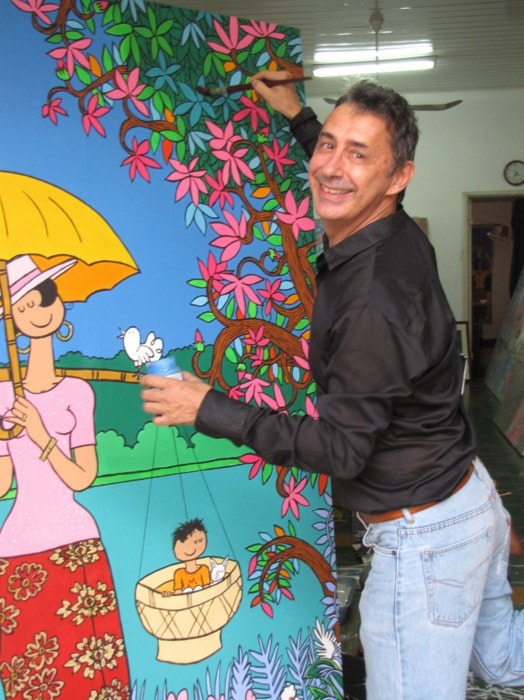PHNOM PENH — It's no wonder that Québec artist Stéphane Delaprée is making Cambodians — and tourists — smile.
His happy-face paintings have given the country a new way of seeing itself and have even won praise from the country's former king, Norodom Sihanouk.
Where most contemporary art in this Southeast Asian country once depicted its famous Angkor temples, now a host of Cambodian artists shamelessly copy Delaprée's hugely popular cartoon style.
The French-born Quebecker was upset when the imitations began appearing 10 years ago.
"But finally this French specialist in image and advertising told me, 'Stéphane, be proud of it. They copy Louis Vuitton and Chanel, and in Vietnam they copy Picasso and all the masters. There are a lot of other artists in Cambodia now and they don't copy them.' "
So Delaprée, who has lived in Phnom Penh since 1994, concluded that his imitators legitimize his simple, colourful style, which he often describes as mignon, or cute, but not quite kitsch.
His large acrylic paintings and smaller silkscreen prints show women carrying fruit on their heads; saffron-robed Buddhist monks walking in single file; whole families on motorcycles, often carrying chickens or pigs; palm trees, water buffalos and elephants.
In Québec, he'd been a cartoonist and edited Bambou, a cartoonists' magazine.
"In my cartoons I used a realistic style. It's funny because 20 years afterward I started to be a painter and I used a cartoon style."
He favours bright colours, including azure, yellow, orange and cotton-candy pink. He starts by drawing on the canvas with a felt pen, and the black outlines remain in the finished work.
Everyone he depicts, even the animals, wears a U-shaped smile. Eyes are smaller semi-circles and no one has a nose. He leaves them out, he said, because many Khmers are sensitive about their noses, feeling they're too broad and flat.
Delaprée, born in 1956, signs his work Stef and makes enough of it to stock four Happy Painting galleries in Cambodia. His two-metre-high canvases sell for as much as $4,000, but most tourists go for the smaller, matted pieces that they can take home for a few dollars.
He employs 16 people — one of them a chauffeur for his black Lexus — to perform the tasks he doesn't enjoy.
"Me, I just want to live from what I do," said Delaprée, who once received a letter from Sihanouk thanking him from his "noble contribution to the social and cultural development" of Cambodia.
A modest man, he used to think he was "not a real artist, but just a guy who had a small talent who was able to live, thanks to tourists." Recent commissions from corporations and art collectors say otherwise.
He believes people enjoy his work because, "It's simple to understand and carries good vibrations. For me, the world is completely crazy and very far from what it should be. And this is just simple: beautiful woman, beautiful papa, little boy, little girl, nice vegetation—just cute."
To view examples of Delaprée's works, visit www.happypainting.net.
For information on travel in Cambodia, visit the Tourism of Cambodia website at www.tourismcambodia.com.
